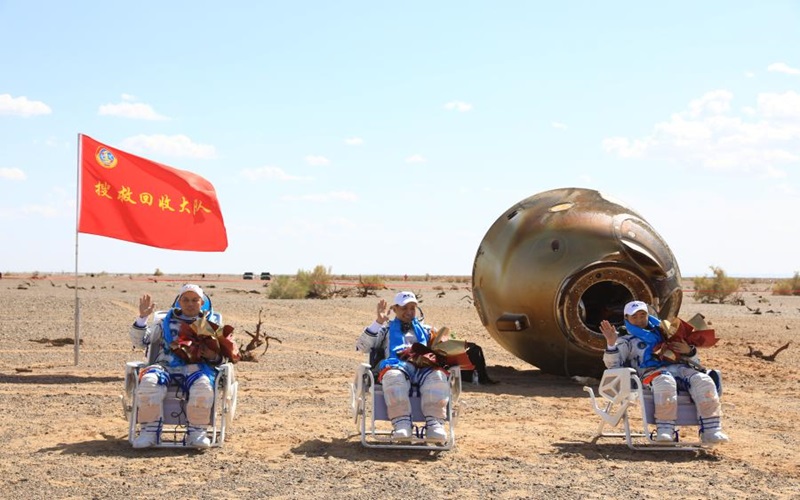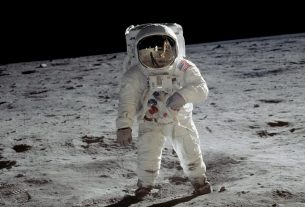The Shenzhou-16 mission, launched on June 10, 2023, marked a significant milestone for China’s +program. The mission was the third crewed flight to China’s new space station, Tiangong, and the longest to date, with a duration of five months. On October 31, 2023, the three astronauts on board the spacecraft safely returned to Earth, completing their mission.
During their time in space, the Shenzhou-16 crew conducted a range of scientific experiments and technical tests, including research on space medicine, space materials, and space environment monitoring. They also performed maintenance tasks on the Tiangong space station, demonstrating China’s growing expertise in space technology and operations.
The successful return of the Shenzhou-16 mission represents a significant achievement for China’s space program and a step forward in its goal of establishing a permanent presence in space. With plans for additional crewed missions to Tiangong and the construction of a larger space station in the coming years, China is poised to become a major player in the global space race.
Mission Overview
On October 31, 2023, China’s Shenzhou-16 manned spaceship successfully returned to Earth after a five-month mission to the country’s Tiangong space station. The mission was launched on May 31, 2023, and marked China’s longest crewed space mission to date.
The Shenzhou-16 mission was the second crewed mission to the Tiangong space station, following the Shenzhou-15 mission which was launched in November 2022. The three astronauts on board the Shenzhou-16 mission were Jing Haipeng (the mission’s commander), Zhu Yangzhu and Gui Haichao.
During their time aboard the Tiangong space station, the crew conducted a range of scientific experiments and technological tests. They also carried out maintenance tasks on the space station and tested new equipment and technologies. The mission was part of China’s broader plans to establish a permanent presence in space and eventually build a space station of its own.
The Shenzhou-16 mission was a significant milestone for China’s space program and demonstrated the country’s growing capabilities in space exploration. The successful return of the crew and the spacecraft marked the end of a challenging and complex mission that involved a range of technical and logistical challenges.
Launch of Shenzhou-16
Shenzhou-16 was a manned spacecraft mission launched by China on May 23, 2023. The spacecraft was launched from the Jiuquan Satellite Launch Center in the Gobi Desert, Inner Mongolia, on a Long March 2F rocket. The mission was part of China’s ambitious space program, which aims to establish a permanent space station and conduct manned missions to the moon.
The crew members of Shenzhou-16 were Jing Haipeng, Zhu Yangzhu, and Gui Haichao. Jing Haipeng was the commander of the mission, and this was his third spaceflight. Zhu Yangzhu and Gui Haichao were both making their first spaceflight.
The launch of Shenzhou-16 was successful, and the spacecraft entered into orbit around the Earth. The crew then docked with the Tiangong space station, which was launched in April 2022. The Tiangong space station is China’s first space station and is expected to be completed by 2023.
During their mission, the crew conducted a series of experiments and tests on the Tiangong space station. They also carried out maintenance work on the station and tested new technologies for future space missions.
The Shenzhou-16 mission lasted for five months, and the crew returned to Earth on October 30, 2023. The spacecraft landed just north of the Jiuquan Satellite Launch Center, Inner Mongolia, at about 8:12 p.m. EDT. The mission was considered a success, and it was a significant milestone for China’s space program.
Astronauts and Their Roles
The Shenzhou-16 mission was manned by three Chinese astronauts who spent five months in space. The astronauts were Jing Haipeng, Zhu Yangzhu, and Gui Haichao.
Jing Haipeng, the mission’s commander, is a veteran astronaut who has previously been on three space missions. He was responsible for overseeing the mission and ensuring that everything ran smoothly.
Zhu Yangzhu was responsible for conducting scientific experiments and collecting data. He has a background in aerospace engineering and was chosen for his expertise in this area.
Gui Haichao was responsible for maintaining the spacecraft and ensuring that everything was in working order. He has a background in mechanical engineering and was chosen for his expertise in this area.
During their time in space, the astronauts conducted a variety of experiments and tests, including growing vegetables and testing new technologies. They also conducted spacewalks to perform maintenance on the space station and to test new equipment.
Overall, the astronauts played critical roles in the success of the Shenzhou-16 mission. Their expertise and dedication to their work ensured that the mission was completed successfully and that valuable data was collected.
Key Experiments Conducted
During the Shenzhou-16 mission, the crew conducted a total of 70 science experiments, covering a wide range of fields such as aerospace medicine, life ecology, biotechnology, materials science, fluid physics, fluid dynamics, aerospace technology, and human factors engineering and technology.
One of the key experiments conducted during the mission was related to the study of space radiation and its impact on the human body. The crew used a radiation detector to measure the levels of radiation inside the spacecraft and recorded their own physical reactions to the radiation exposure. This experiment will provide valuable data for future space missions, as it will help scientists better understand the effects of long-term exposure to space radiation on the human body.
Another significant experiment conducted during the mission was related to the development of a new type of plant cultivation system for use in space. The crew used this system to grow various types of plants, including lettuce and wheat, in the microgravity environment of the spacecraft. This experiment will help scientists develop new methods for growing food in space, which will be crucial for long-term space missions.
In addition to these experiments, the crew also performed maintenance on the space station, including one nearly eight-hour spacewalk, which was aimed at testing new space suit technology and conducting repairs on the exterior of the station.
Overall, the Shenzhou-16 mission was a major success, and the experiments conducted during the mission will provide valuable data for future space missions and help pave the way for the development of new technologies and methods for space exploration.
Technical Aspects of Shenzhou-16
Shenzhou-16 was China’s fifth crewed mission to space and the third to dock with the Tiangong space station. The mission was launched on June 5, 2023, and lasted for 153 days. The spacecraft was launched using the Long March 2F rocket from the Jiuquan Satellite Launch Center in the Gobi Desert.
The crew consisted of three taikonauts: Jing Haipeng, Zhu Yangzhu, and Gui Haichao. During their stay aboard the Tiangong space station, they conducted a series of experiments and maintenance tasks. They also tested new space suits and conducted a spacewalk to install equipment on the station’s exterior.
The Shenzhou-16 spacecraft used for the return journey consisted of a return capsule and an orbital module. The return capsule carried the three taikonauts and landed safely in the Dongfeng landing site in north China’s Inner Mongolia Autonomous Region on October 31, 2023, at 8:11 a.m. Beijing Time. The return capsule separated from the orbital module at 7:21 a.m.
According to the China Manned Space Agency, the Shenzhou-16 spacecraft was equipped with several advanced technologies. These included:
- A new generation of life support systems that provided a more comfortable living environment for the taikonauts.
- A new thermal control system that could maintain a stable temperature inside the spacecraft.
- An advanced rendezvous and docking system that allowed the spacecraft to dock with the Tiangong space station automatically.
- New space suits that were more durable and provided better mobility for the taikonauts during their spacewalk.
Overall, the technical aspects of the Shenzhou-16 mission demonstrated China’s growing capabilities in space exploration and highlighted the country’s commitment to advancing space technology.
Return and Recovery
On October 31, 2023, the Shenzhou-16 manned spacecraft safely returned to Earth after spending 154 days in space. The return capsule carrying the three taikonauts, led by mission commander Jing Haipeng, landed at the Dongfeng Landing Site in Inner Mongolia Autonomous Region at 8:11 a.m. local time. The on-site medical team confirmed that all three taikonauts were in good health.
The successful return of the Shenzhou-16 mission marked a significant milestone for China’s space program. It was the first manned mission to the Tiangong space station since its completion, and it demonstrated China’s growing capabilities in space exploration.
The recovery team quickly moved to retrieve the return capsule and transfer the taikonauts to a nearby medical facility for further evaluation. The team also began the process of recovering the spacecraft and conducting post-flight analyses.
According to the China Manned Space Agency, the Shenzhou-16 mission was a resounding success. The mission achieved all of its objectives and demonstrated China’s ability to conduct long-duration manned missions in space.
Overall, the return and recovery of the Shenzhou-16 mission was a significant accomplishment for China’s space program. It demonstrated China’s growing capabilities in space exploration and represented a major step forward in the country’s efforts to establish a permanent presence in space.
Impact on China’s Space Program
The successful return of the Shenzhou-16 mission is a significant milestone for China’s space program. With this mission, China has demonstrated its ability to conduct long-duration crewed missions and maintain a space station in orbit.
One of the key objectives of the Shenzhou-16 mission was to test the Tiangong space station’s life support systems and conduct scientific experiments. The crew also performed maintenance tasks on the space station, demonstrating China’s ability to operate and maintain a space station in orbit.
The success of the Shenzhou-16 mission is a significant step forward for China’s space program. It demonstrates China’s ability to develop and operate advanced space technologies, including spacecraft, launch vehicles, and space stations.
China’s space program has made significant progress in recent years, with a series of successful missions to the moon and Mars. The success of the Shenzhou-16 mission will further enhance China’s position as a major player in the global space industry.
Moving forward, China plans to continue developing its space program, with plans for additional crewed missions to the Tiangong space station and further exploration of the moon and Mars. The success of the Shenzhou-16 mission provides a strong foundation for these future endeavors and demonstrates China’s commitment to advancing its space capabilities.
Global Reactions
The successful return of the Shenzhou-16 mission has garnered global attention and praise. Here are some reactions from around the world:
- China: The Chinese government and media have hailed the mission as a major achievement for the country’s space program. President Xi Jinping congratulated the astronauts and the mission control team, saying that the successful return “demonstrated China’s strong space capabilities and the spirit of Chinese astronauts.”
- United States: NASA Administrator Bill Nelson congratulated China on the successful mission and expressed hope for future cooperation between the two countries in space exploration. However, some American officials have raised concerns about China’s growing space capabilities and its military applications.
- Russia: Russian officials have also congratulated China on the successful mission and expressed interest in future cooperation. Russia and China have been working together on space projects in recent years, including joint missions to the International Space Station.
- European Union: The European Space Agency (ESA) congratulated China on the successful mission and expressed interest in collaborating with China on future space projects. The ESA has been working with China on the Chang’e lunar exploration program and other projects.
- India: Indian Prime Minister Narendra Modi congratulated China on the successful mission and expressed hope for future cooperation between the two countries in space exploration. India has its own ambitious space program, including plans for a manned mission to space in the near future.
Overall, the successful return of the Shenzhou-16 mission has been widely praised as a major achievement for China’s space program and a step forward for international cooperation in space exploration.
Future Implications
The success of the Shenzhou-16 mission is a significant milestone in China’s ambitious space program. The mission has demonstrated China’s ability to build and operate a space station, paving the way for future manned missions and scientific research.
China’s space program has been steadily growing over the years, and the successful completion of the Shenzhou-16 mission is a testament to the country’s determination to become a major player in the space race. The mission has provided valuable data and insights into the challenges of long-duration spaceflight, which will be crucial for future missions to the Moon and Mars.
One of the key implications of the Shenzhou-16 mission is that China is now capable of conducting independent space operations without relying on other countries. This capability will be critical for China’s future space ambitions, which include building a permanent space station and sending astronauts to the Moon.
The success of the Shenzhou-16 mission is also likely to have geopolitical implications. China’s growing space program has raised concerns among some countries, particularly the United States, which sees China as a potential rival in space exploration. However, China has repeatedly stated that its space program is peaceful and that it is committed to international cooperation in space exploration.
Overall, the success of the Shenzhou-16 mission is a significant achievement for China’s space program and has important implications for the future of space exploration.

Email: ben@satprwire.com Phone: +44 20 4732 1985
Ben has been listening to the technology news for quite some time that he needs just a single read to get an idea surrounding the topic. Ben is our go-to choice for in-depth reviews as well as the normal articles we cover on a normal basis.



